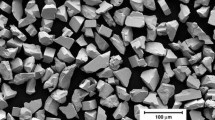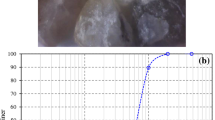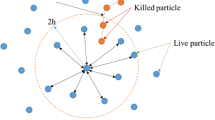Abstract
The shock wave perturbation decay experiment is a technique in which the evolution of a perturbation in a shock wave front is monitored as it propagates through a material field. This tool has recently been explored to probe the high-rate shear response of granular materials. This dynamic behavior is complicated due to inter- and intra-granular phenomena involved. Mesoscale modeling can give insight into this complexity by explicitly resolving the interactions and deformation of individual grains. The peridynamic theory, which is a nonlocal continuum theory, provides a suitable framework for modeling dynamic problems involving fracture. Prior research has focused mostly on the continuum, bulk response, neglecting any localized material failure, of granular materials. A systematic investigation of the effects of grain fracture and frictional contact forces between grains on the continuum behavior of granular materials is carried out by peridynamic simulations of a shock wave perturbation decay experiment. A sensitivity assessment of dominant factors indicates that grain fracture, a phenomenon ignored in most computational investigations of granular materials, plays a large role in the bulk dynamic response. Our results show that the wave propagates faster with an increase in the toughness of the material and the inter-particle friction. Also, the shock amplitude is shown to decay faster in tougher materials. It is further confirmed that under strong compression self-contact among fractured grain sub-particles cannot be neglected.




















Similar content being viewed by others
References
Sakharov AD, Zaidel RM, Mineev VN, Oleinik AG (1965) Experimental investigation of the stability of shock waves and the mechanical properties of substances at high pressures and temperatures. Sov Phys JETP 9:1091–1094
Mineev VN, Savinov EV (1967) Viscosity and melting point of aluminum, lead, and sodium chloride subjected to shock compression. Sov Phys JETP 25:411–416
Mineev VN, Zaidel RM (1968) The viscosity of water and mercury under shock loading. Sov Phys JETP 27:874–878
Miller GH, Ahrens TJ (1991) Shock-wave viscosity measurement. Rev Mod Phys 63(4):919–948
Mineev VN, Funtikov AI (2004) Viscosity measurements on metal melts at high pressure and viscosity calculations for the Earth’s core. Phys-Uspekhi 47:671–686
Mineev VN, Funtikov AI (2005) Measurements of the viscosity of water under shock compression. High Temp 43:141–150
Mineev VN, Funtikov AI (2006) Measurements of the viscosity of iron and uranium under shock compression. High Temp 44:941–949
Liu FS, Yang MX, Liu QW, Chen JX, Jing FQ (2005) Shear viscosity of aluminum under shock compression. Chin Phys Lett 22:747–749
Li-Peng F, Fu-Sheng L, Xiao-Juan M, Bei-Jing Z, Ning-Chao Z, Wen-Peng W, Bin-Bin H (2013) A fiber-array probe technique for measuring the viscosity of a substance under shock compression. Chin Phys B 22:108301
Li Y, Liu F, Ma X, Li Y, Yu M, Zhang J, Jing F (2009) A flyer-impact technique for measuring viscosity of metal under shock compression. Rev Sci Instrum 80(1):013903
Ma XJ, Liu FS, Zhang MJ, Sun YY (2011) Viscosity of aluminum under shock-loading conditions. Chin Phys B 20:068301
Li YL, Liu FS, Zhang MJ, Ma XJ, Li YL, Zhang JC (2009) Measurement on effective shear viscosity coefficient of iron under shock compression at 100 GPa. Chin Phys Lett 26:038301
Ma X, Liu FS, Sun Y, Zhang M, Peng X, Li Y (2011) Effective shear viscosity of iron under shock-loading condition. Chin Phys Lett 28:044704
Vogler TJ (2015) Shock wave perturbation decay in granular materials. J Dyn Behav Mat 1:370–387
Vogler TJ, Behzadinasab M, Rahman R, Foster JT (2016) Perturbation decay experiments on granular materials. Sandia National Laboratories Report 2016
Benson DJ (1997) The numerical simulation of the dynamic compaction of powders. In: Davison L, Horie Y, Shahinpoor M (eds) High-pressure shock compression of solids IV: response of highly porous solids to shock loading. Springer, New York, pp 233–255
Borg JP, Vogler TJ (2008) Mesoscale calculations of the dynamic behavior of a granular ceramic. Int J Solids Struct 45:1676–1696
Borg JP, Vogler TJ (2009) Aspects of simulating the dynamic compaction of a granular ceramic. Modell Simul Mater Sci Eng 17:045003
Borg JP, Vogler TJ (2013) Rapid compaction of granular materials: characterizing two and three-dimensional mesoscale simulations. Shock Waves 23:153–176
Dwivedi SK, Teeter RD, Felice CW, Gupta YM (2008) Two dimensional mesoscale simulations of projectile instability during penetration in dry sand. J Appl Phys 104:083502
Dwivedi SK, Pei L, Teeter RD (2015) Two-dimensional mesoscale simulations of shock response of dry sand. J Appl Phys 117:085902
Lammi CJ, Vogler TJ (2012) Mesoscale simulations of granular materials with peridynamics. In: Elert ML (ed) Shock compression of condensed matter-2011. American Institute of Physics, New York, pp 1467–1470
Vogler TJ, Borg JP, Grady DE (2012) On the scaling of steady structured waves in heterogeneous materials. J Appl Phys 112:123507
Silling SA (2000) Reformulation of elasticity theory for discontinuities and long-range forces. J Mech Phys Solids 48:175–209
Silling SA (2003) Dynamic fracture modeling with a meshfree peridynamic code. In: Bathe KJ (ed) Computational fluid and solid mechanics. Elsevier, Amsterdam, p 641644
Foster JT, Silling SA, Chen WW (2010) Viscoplasticity using peridynamics. Int J Numer Meth Eng 81:1242–1258
Silling SA, Epton M, Weckner O, Xu J, Askari E (2007) Peridynamic states and constitutive modeling. J Elast 88:151–84
Silling SA, Askari E (2005) A meshfree method based on the peridynamic model of solid mechanics. Comput Struct 83:1526–1535
Silling SA, Askari E (2004) Peridynamic modeling of impact damage. In: ASME/JSME 2004 pressure vessels and piping conference. American Society of Mechanical Engineers, pp 197-205
Behzadinasab M, Vogler TJ, Foster JT (2018) Modeling perturbed shock wave decay in granular materials with intra-granular fracture. In: AIP conference proceedings of the 20th APS-SCCM, vol 1979
Parks ML, Littlewood DJ, Mitchell JA, Silling SA (2012) Peridigm users guide. Sandia National Laboratories Report 2012
Heroux MA, Bartlett RA, Howle VE, Hoekstra RJ, Hu JJ, Kolda TG, Salinger AG (2005) An overview of the Trilinos project. ACM TOMS 31:397–423
Acknowledgements
We greatly appreciate the financial support from the AFOSR MURI Center for Materials Failure Prediction through Peridynamics and Sandia National Laboratories. Sandia National Laboratories is a multi-mission laboratory managed and operated by National Technology and Engineering Solutions of Sandia, LLC., a wholly owned subsidiary of Honeywell International, Inc., for the U.S. Department of Energy’s National Nuclear Security Administration under contract DE-NA0003525.
Author information
Authors and Affiliations
Corresponding author
Rights and permissions
About this article
Cite this article
Behzadinasab, M., Vogler, T.J., Peterson, A.M. et al. Peridynamics Modeling of a Shock Wave Perturbation Decay Experiment in Granular Materials with Intra-granular Fracture. J. dynamic behavior mater. 4, 529–542 (2018). https://doi.org/10.1007/s40870-018-0174-2
Received:
Accepted:
Published:
Issue Date:
DOI: https://doi.org/10.1007/s40870-018-0174-2




